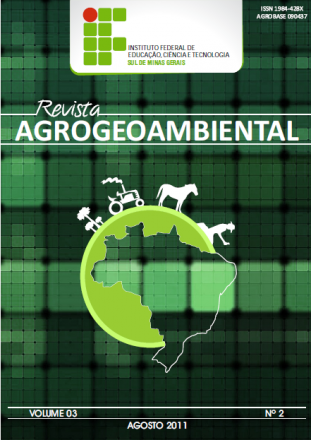Ginger extract as an alternative to thrips (Thrips tabaci) control in hydroponic lettuce
Revista Agrogeoambiental
Ginger extract as an alternative to thrips (Thrips tabaci) control in hydroponic lettuce
Autor Correspondente: S. Silva | [email protected]
Palavras-chave: natural insecticides, alternative control, protected cultivation, hydroponics, insecticidal property.
Resumos Cadastrados
Resumo Português:
O gengibre apresenta grande quantidade de óleos essenciais, sendo o zingibereno a substância majoritária e que pode es-tar interligado à atividade inseticida do vegetal. Desta forma, pode constituir-se em uma alternativa viável na substituição do uso de defensivos agrícolas para o controle de pragas. O objetivo deste trabalho foi avaliar a utilização de extrato à base de gengibre em alface hidropônica como alternativa ao controle de tripes. O experimento foi realizado em delineamento em blocos casualizados, com cinco tratamentos e quatro repetições. Os tratamentos utilizados foram as concentrações de 0 %, 20 %, 40 %, 60 % e 80 % peso/volume de extrato aquoso. Após 45 dias da semeadura, foi realizada aplicação do extra-to vegetal de gengibre nas plantas de alface a cada sete dias. Foi monitorada a população de tripes a partir de armadilhas adesivas, presas acima de cada parcela experimental, a cada semana até a colheita. Além disso, foram avaliados peso da matéria fresca, altura da parte aérea e incidência de danos diretos na cultura. Em relação ao monitoramento de tripes, não foram observadas diferenças significativas indicando a uniformidade do nível populacional entre as parcelas da alface. Para a avaliação de peso e matéria fresca, não foram observadas diferenças significativas entre tratamentos. Entretanto, a partir da concentração de 60 % foram observadas as menores médias de plantas com danos diretos, mostrando que quanto maior a concentração da solução, menor alimentação do inseto. Portanto, o uso de extrato vegetal de gengibre em alface hidropô-nica se torna uma alternativa promissora para a redução da alimentação de tripes em alface.
Resumo Inglês:
Ginger has a large number of essential oils, zingiberene is the major substance found in it, which may be linked to the insecticidal activity of the plant. Therefore, it can be a viable alternative to replace the use of pesticides for pest control. The objective of this work was to evaluate the use of this ginger-based extract in hydroponic lettuce as an alternative to thrips control. The experiment was carried out in a randomized block design, with five treatments and four replications. The treatments used were the concentrations of 0 %, 20 %, 40 %, 60 %, and 80 % weight/volume of aqueous extract. After 45 days of sowing, the ginger plant extract was applied to the lettuce plants every seven days. A population of thrips was monitored using adhesive traps attached above each experimental plot once a week until harvest. In addition, fresh mass weight, shoot height, and incidence of direct damage to the crop were evaluated. Regarding thrips monitoring, no differences were observed indicating the uniformity of the population level among the lettuce parcels. For the evaluation of weight and fresh mass, no differences were observed regarding the treatments. However, from the concentration of 60 %, it was observed the lowest averages of plants with direct damage, showing that the higher the concentration of the solution the lesser insect feeding. Accordingly, the use of ginger plant extract in hydroponic lettuce becomes a promising alternative for reducing thrips feeding on lettuce.

